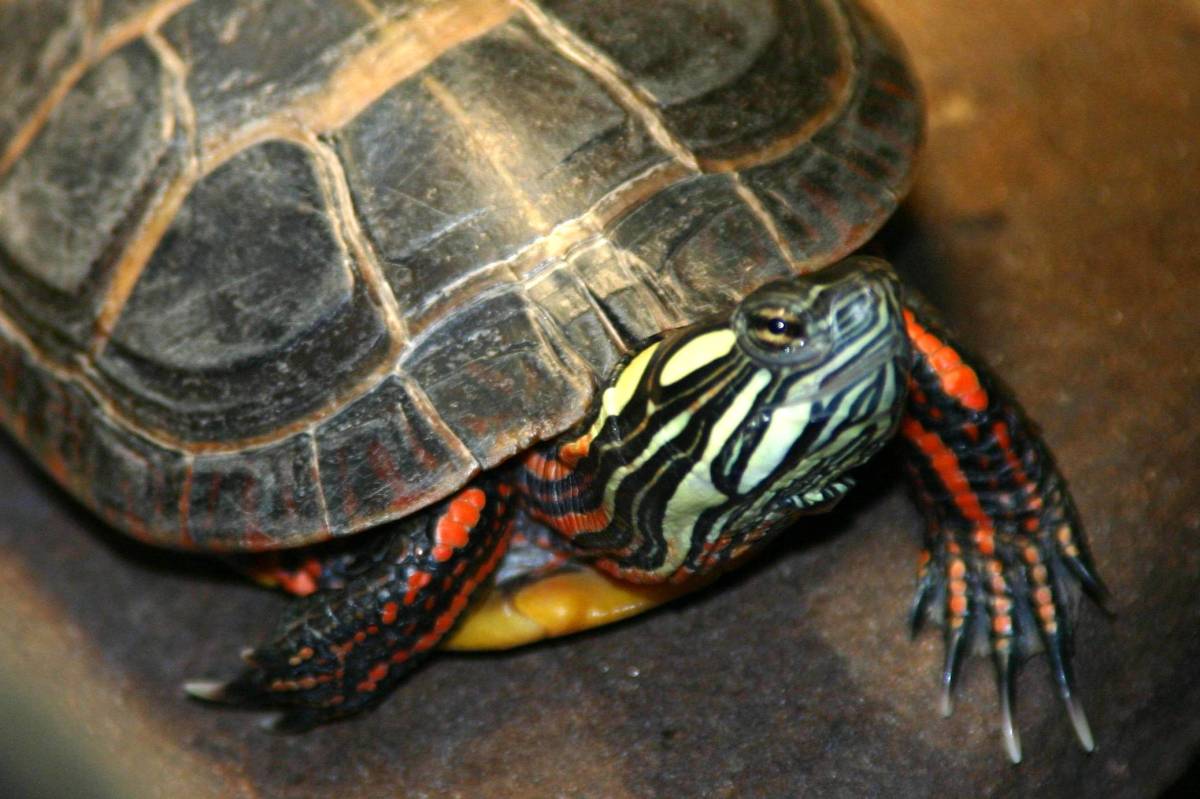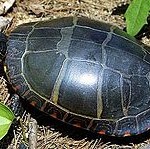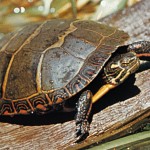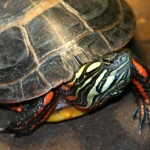Painted Turtle Facts
Scientific Classification of Painted Turtle: Chrysemys Picta.
Kingdom of Painted Turtle: Animalia
Phylum of Painted Turtle: Chordata
Class of Painted Turtle: Reptilia
Order of Painted Turtle: Testudines
Family of Painted Turtle: Emididae
Genus of Painted Turtle: Chrysemys
Species of Painted Turtle: C.picta
Pictures of Painted Turtle
Some Exciting Facts about Painted Turtle
Read along to know some interesting facts about Painted Turtle below:
- Painted Turtle males are smaller than the females.
- It is recognized as one of the beautiful motley colored species.
- The males reach sexual maturity much before compared to females.
- The mating between them takes place in the water.
- These species usually hibernate during winter.
- They can survive for long without the supply of oxygen
- Till now, only 4 sub-species of the painted turtle have been discovered.
Distribution of Painted Turtle
These species inhabit largely along the coasts from Pacific to the Atlantic. They are also found in about 45 American states and 18 Canadian states.
Description of Painted Turtle
Size of The Painted Turtle: As compared to males, the female counterparts are longer in body size. The females vary between 4 – 10 inches in size, whereas the males are 3 to 6 inches. Shells may also vary.
Color of The Painted Turtle: The shells are mostly found in black or olive colors. Infact, the skin also depends on the shell’s color. The lower portion of the turtle’s shell is red or yellow in color while the central portion is dark colored. Moreover, the legs, tail and the neck are dotted with red and yellow marks.
Head of The Painted Turtle: A short neck connects the head to the body. Well these species are devoid of any ears. They have bulging eyes on either side of the face. The nose too is located on the face of the turtle.
Body of The Painted Turtle: Beneath the hard external shell of the turtle lies a soft fleshy skin.
Limbs of The Painted Turtle: These species have webbed limbs.
Sub Species – Painted Turtle
The four subspecies of Painted Turtle are as follows:
- Eastern Painted Turtle
- Western Painted Turtle
- Midland Painted Turtle
- Southern Painted Turtle
Food Habits of Painted Turtle
Well, these species are essentially omnivorous in nature. Therefore, they primarily feed on both living & dead animals. However, the food habits of the sub species are quite different. Descripton of some of those habits are discussed below.
- Eastern painted turtle likes to feed on dead or injured fishes.
- Western painted turtle prefer to have plants and animals in their diet.
- While the midland painted turtle thrives on non-vascular and vascular insects.
- The southern painted turtle have both plants and animals. The younger ones feed on animals while the elder ones like plants.
Behavior of Painted Turtle
- These species are omnivorous.
- The sub species feed on plants, animals or insects in their diet.
- They like to mate in the profound bottoms of water bodies.
- When they sense something strange, they hide themselves within their tough shells.
- These species can survive for long months without external oxygen.
- Similar to other reptiles, they also hibernate.
Habitat of Painted Turtle
These species like to dwell in fresh water. They are also found in ponds, lakes and marshy areas.
Hibernation of Painted Turtle
These species hibernate during the winter months. They usually do so, on sea shores or of other water areas. They can often be found hibernating in the woodlands and forest close to the proximity of the water areas.
Predators of Painted Turtle
- Crows
- Garter snakes
- Squirrels
- Raccoons
- Alligators
- Crows
- Rice rats
- Herons
- Minks
- Foxes
Adaptations of Painted Turtle
- The color of these species helps them to camouflage in danger.
- These species move very slowly. Neither their predator nor the prey gets any hint of their presence.
- They have an active blood, nerve and brain that help them to survive without oxygen
- Last but not the least these species are not harmful at all.
Mating Season of Painted Turtle
These species usually mate from mid of April to end of July.
Reproduction of Painted Turtle
As compared to females, males have longer claws. The males touch the cheeks of their partners to express their love. When both them are prepared to mate they swim into the bottom of water bodies. The females usually lay 4 to 20 eggs in open areas.
Life Cycle of Painted Turtle
Post hatching, the off springs rest in the yolks of the egg itself. The younger ones grow rapidly. Infact the development of the females are faster than that of the males. In case of the painted turtle, the males reach their sexual maturity between 2 to 4 years while females between 6 to 10 years.
Lifespan Of Painted Turtle
These species usually survive for an average of 20 years.
Caring Of Painted Turtle
Laws to Be Followed: The animal protection Laws prohibits the petting of the painted turtle. It is necessary to adhere to the laws and also get proper permissions if one desires to do so.
Housing Necessary: Proper quantity of water should be given along with a provision for basking. At the same time, the water needs to be changed on a daily basis.
Proper Temperature: The temperature of the water should be maintained above 30 degree Celsius.
Proper Foods: The food totally depends on the sub species one is petting. One should provide them with vitamin supplements too to complement the nutrients of the food.
Conservation Status of Painted Turtle
According to IUCN, these species are in the category of least important ones in the endangered list. They conservation status is perfectly okay.




